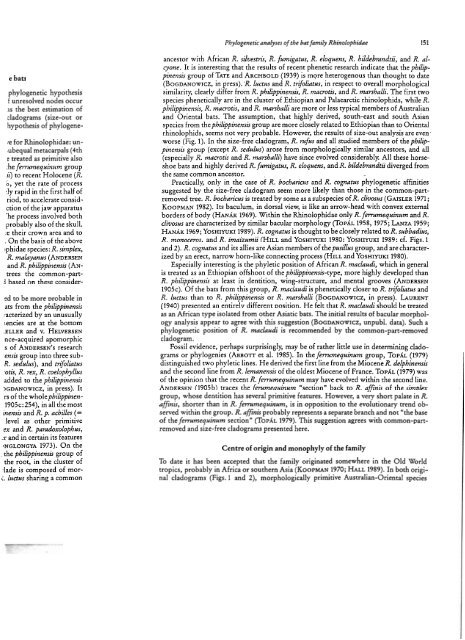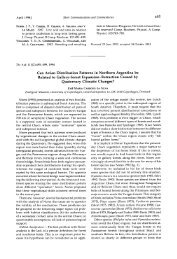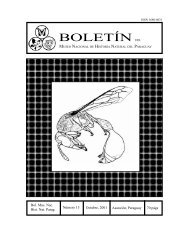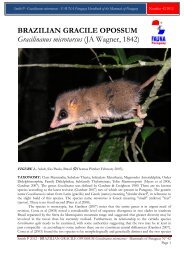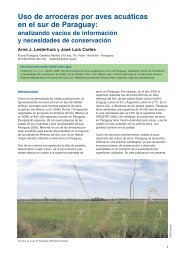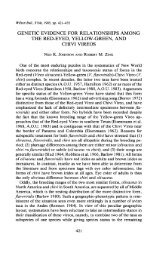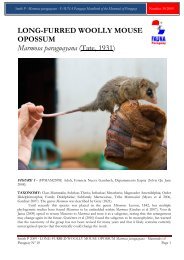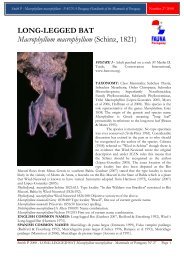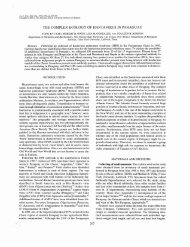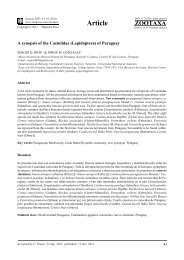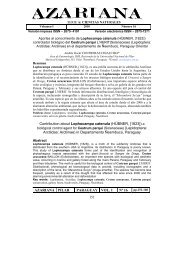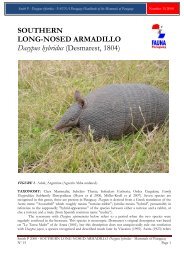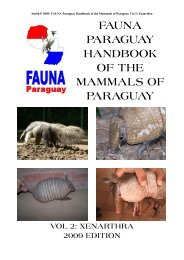Phylogenetic analyses of the bat family ... - FAUNA Paraguay
Phylogenetic analyses of the bat family ... - FAUNA Paraguay
Phylogenetic analyses of the bat family ... - FAUNA Paraguay
You also want an ePaper? Increase the reach of your titles
YUMPU automatically turns print PDFs into web optimized ePapers that Google loves.
e <strong>bat</strong>s<br />
phylogenetic hypo<strong>the</strong>sis<br />
f unresolved nodes occur<br />
1s <strong>the</strong> best estimation <strong>of</strong><br />
zladograms (size-out or<br />
hypo<strong>the</strong>sis <strong>of</strong> phylogene-<br />
re for Rhinolophidae: un-<br />
,ubequal metacarpals (4th<br />
e treated as primitive also<br />
:he ferrumequinum group<br />
it1 to recent Holocene (R.<br />
b, yet <strong>the</strong> rate <strong>of</strong> process<br />
:ly rapid in <strong>the</strong> first half <strong>of</strong><br />
riod. to accelerate consid-<br />
ction <strong>of</strong><strong>the</strong> jaw apparatus<br />
'he process involved both<br />
probably also <strong>of</strong> <strong>the</strong> skull.<br />
:e <strong>the</strong>ir crown area and to<br />
. On <strong>the</strong> basis <strong>of</strong> <strong>the</strong> above<br />
lphidae species: R. simplex,<br />
R. malayanus (ANDERSEN<br />
and R. philippinensis (AN-<br />
trees <strong>the</strong> common-part-<br />
1 based on <strong>the</strong>se consider-<br />
-d to be more ~robable in<br />
ats from <strong>the</strong> philippinensis<br />
cacterized by an unusually<br />
iencies are it <strong>the</strong> bottom<br />
.ELLER and v. HELVERSEN<br />
nce-acquired apomorphic<br />
s <strong>of</strong> ANDERSEN'S research<br />
.ensis group into three sub-<br />
R. sedulus), and trifoliatus<br />
~tis, R. rex, R. coelophyllus<br />
added to <strong>the</strong> philippinensis<br />
IGDANOWICZ, in press). It<br />
rs <strong>of</strong> <strong>the</strong> wholephilippinen-<br />
1905c:254), in all <strong>the</strong> most<br />
inensis and R. D. achilles (=<br />
level as o<strong>the</strong>r primitive<br />
.ex and R. paradoxolophus,<br />
:r and in certain its features<br />
INGLONGYA 1973). On <strong>the</strong><br />
<strong>the</strong> philippinensis group <strong>of</strong><br />
<strong>the</strong> root, in <strong>the</strong> cluster <strong>of</strong><br />
,lade is composed <strong>of</strong> mor-<br />
;. luctus sharing a common<br />
<strong>Phylogenetic</strong><strong>analyses</strong> <strong>of</strong> <strong>the</strong> <strong>bat</strong> <strong>family</strong> Rhinolophidae 151<br />
ancestor with African R. silvestris, R. fumigatus, R. eloquens, R. hildebrandtii, and R, alcyone.<br />
It is interesting that <strong>the</strong> results <strong>of</strong> recent phenetic research indicate that <strong>the</strong>philippinensis<br />
group <strong>of</strong> TATE and ARCHBOLD (1939) is more heterogenous than thought to date<br />
(BOGDANOWICZ, in press). 2. luctus and R. trifoliatus, in respect to overall morphological<br />
similarity, clearly differ from R. philippinensis, R. macrotis, and R. marshalli. The first two<br />
s~ecies oheneticallv are in <strong>the</strong> cluster <strong>of</strong> Ethiopian and Palaearctic rhinolouhids. while R.<br />
philippinensis, R. macrotis, and R. marshalli are more or less typical members <strong>of</strong> Australian<br />
and Oriental <strong>bat</strong>s. The assumption, that highly derived, south-east and south Asian<br />
species from <strong>the</strong> philippinensis group are more closely related to Ethiopian than to Oriental<br />
rhinolophids, seems not very probable. However, <strong>the</strong> results <strong>of</strong> size-out analysis are even.<br />
worse (Fig. 1). In <strong>the</strong> size-free cladogram, R. rufus and all studied members <strong>of</strong> <strong>the</strong> philippinensis<br />
group (except R. sedulus) arose from morphologically similar ancestors, and all<br />
(especially R. macrotis and R. marshalli) have since evolved considerably. All <strong>the</strong>se horseshoe<br />
<strong>bat</strong>s and highly derived R. fumigatus, R. eloquens, and R. hildebrandtii diverged from<br />
<strong>the</strong> same common ancestor.<br />
Practically, only in <strong>the</strong> case <strong>of</strong> R. bocharicus and R. cognatus phylogenetic affinities<br />
suggested by <strong>the</strong> size-free cladogram seem more likely than those in <strong>the</strong> common-partremoved<br />
tree. R. bocharicus is treated bv some as a subs~ecies <strong>of</strong> R. clivosus ~GAISLER 1971 :<br />
KOOPMAN 1982). Its baculum, in dorsal view, is like an arrow-head with convex external<br />
borders <strong>of</strong> body ( HAN~ 1969). Within <strong>the</strong> Rhinolophidae only R. ferrumequinum and R.<br />
clivosus are characterized by similar bacular morphology (TOPAL 1958, 1975; LANZA 1959;<br />
HANAK 1969; YOSHIYUKI 1989). R. cognatus is thought to be closely related to R. subbadius,<br />
R. monoceros. and R, imaizumii (HILL and YOSHIWKI 1980: YOSHIWKI 1989: cf. Fies. " 1<br />
and 2). R. cognatus and its allies are Asian members <strong>of</strong> <strong>the</strong>pusillus group, and are characterized<br />
by an erect, narrow horn-like connecting process (HILL and YOSHIWKI 1980).<br />
Especially interesting is <strong>the</strong> phyletic position <strong>of</strong> African R. maclaudi, which in general<br />
is treated as an Ethiopian <strong>of</strong>fshoot <strong>of</strong> <strong>the</strong> philippinensis-type, more highly developed than<br />
R. philippinensis at least in dentition, wing-structure, and mental grooves (ANDERSEN<br />
1905~). Of <strong>the</strong> <strong>bat</strong>s from this group, R. maclaudi is phenetically closer to R. trifoliatus and<br />
R. luctus than to R. philippinensis or R. marshalli (BOGDANOWICZ, in press). LAURENT<br />
(19401 resented an entirelv different ~osition. He felt that R. maclaudi should be treated<br />
\ , L<br />
as an African type isolated from o<strong>the</strong>r Asiatic <strong>bat</strong>s. The initial results <strong>of</strong> bacular morphology<br />
analysis appear to agree with this suggestion (BOGDANOWICZ, unpubl. data). Such a<br />
phylogenetic position <strong>of</strong> R. maclaudi is recommended by <strong>the</strong> common-part-removed<br />
cladogram.<br />
Fossil evidence, perhaps surprisingly, may be <strong>of</strong> ra<strong>the</strong>r little use in determining cladograms<br />
or phylogenies (ABBO~ et al. 1985). In <strong>the</strong> femmequinum group, TOPAL (1979)<br />
distinguished two phyletic lines. He derived <strong>the</strong> first line from <strong>the</strong> Miocene R. delphinensis<br />
and <strong>the</strong> second line from R. lemanensis <strong>of</strong> <strong>the</strong> oldest Miocene <strong>of</strong> France. TOPAL (1979) was<br />
<strong>of</strong> <strong>the</strong> opinion that <strong>the</strong> recent R. ferrumequinum may have evolved within <strong>the</strong> second line.<br />
ANDERSEN (1905b) traces <strong>the</strong> ferumeauinum "section" back to R. affinis ,, <strong>of</strong> <strong>the</strong> sim~lex<br />
group, whose dentition has several primitive features. However, a very short palate in R.<br />
affinis, shorter than in R. fmmequinum, is in opposition to <strong>the</strong> evolutionary trend observed<br />
within <strong>the</strong> group. R. affinis probably represents a separate branch and not "<strong>the</strong> base<br />
<strong>of</strong> <strong>the</strong> ferrumequinum section" (TOPAL 1979). This suggestion agrees with common-part-<br />
- -<br />
removed and size-free cladograms presented here.<br />
Centre <strong>of</strong> origin and monophyly <strong>of</strong> <strong>the</strong> <strong>family</strong><br />
To date it has been accepted that <strong>the</strong> <strong>family</strong> originated somewhere in <strong>the</strong> Old World<br />
tropics, probably in Africa or sou<strong>the</strong>rn Asia (KOOPMAN 1970; HALL 1989). In both original<br />
cladograms (Figs. 1 and 2), morphologically primitive Australian-Oriental species


